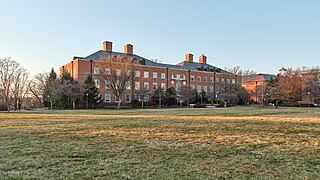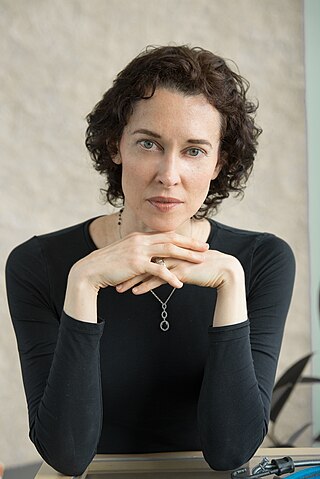The University of Texas Southwestern Medical Center is a public academic health science center in Dallas, Texas. With approximately 23,000 employees, more than 3,000 full-time faculty, and nearly 4 million outpatient visits per year, UT Southwestern is the largest medical school in the University of Texas System and the State of Texas.

The Indiana University School of Medicine (IUSM) is a major, multi-campus medical school located throughout the U.S. state of Indiana and is the graduate medical school of Indiana University. There are nine campuses throughout the state; the principal research, educational, and medical center is located on the campus of Indiana University Indianapolis. With 1,461 MD students, 195 PhD students, and 1,442 residents and fellows in the 2023–24 academic year, IUSM is the largest medical school in the United States. The school offers many joint degree programs including an MD/PhD Medical Scientist Training Program. It has partnerships with Purdue University's Weldon School of Biomedical Engineering, other Indiana University system schools, and various in-state external institutions. It is the medical school with the largest number of graduates licensed in the United States per a 2018 Federation of State Medical Boards survey with 11,828 licensed physicians.

Regenerative medicine deals with the "process of replacing, engineering or regenerating human or animal cells, tissues or organs to restore or establish normal function". This field holds the promise of engineering damaged tissues and organs by stimulating the body's own repair mechanisms to functionally heal previously irreparable tissues or organs.
Articles related specifically to biomedical engineering include:
Clifford E. Brubaker is Dean of the School of Health and Rehabilitation Sciences at the University of Pittsburgh. Brubaker is also a professor at that institution and an adjunct professor at both Xian Jiaotong University and Carnegie Mellon University.

David M. Brienza is a professor of rehabilitation science at the University of Pittsburgh School of Health and Rehabilitation Sciences. He holds additional professorial appointments in bioengineering and electrical engineering.
Following is a list of topics related to life extension:
Peter W. Zandstra, is a Canadian scientist who is the Director of the Michael Smith Laboratories at the University of British Columbia.

Gordana Vunjak-NovakovicFRSC is a Serbian American biomedical engineer and university professor. She is a University Professor at Columbia University, as well as the Mikati Foundation Professor of Biomedical Engineering and Medical Sciences. She also heads the laboratory for Stem Cells and Tissue Engineering at Columbia University. She is part of the faculty at the Irving Comprehensive Cancer Center and the Center for Human Development, both found at Columbia University. She is also an honorary professor at the Faculty of Technology and Metallurgy at the University of Belgrade, an honorary professor at the University of Novi Sad, and an adjunct professor at the Department of Biomedical Engineering at Tufts University.
Martin (Maish) L. Yarmush is an academic, American scientist, physician, and engineer known for his work in biotechnology and bioengineering. His faculty career began in 1984 at MIT in the Department of Chemical Engineering as a Principal Research Associate and Lucille P. Markey Scholar in Biomedical Science. In 1988 he joined Rutgers University, as Professor of Chemical and Biochemical Engineering and a member of the Center of Advanced Biotechnology and Medicine. In 1995, he returned to the Boston area to serve as the Helen Andrus Benedict Professor of Surgery and Bioengineering in the Harvard-MIT Division of Health Sciences and Technology, and to establish the Center for Engineering in Medicine at the Harvard Affiliated Teaching Hospitals. In 2007 he returned to Rutgers to hold the Paul and Mary Monroe Endowed Chair in Science and Engineering and serve as Distinguished Professor in the Department of Biomedical Engineering. He also holds a Lecturer in Surgery and Bioengineering position at Harvard Medical School, and is a member of the Senior Scientific Staff at the Shriners children's hospital in Boston.
Robert M. Nerem, often referred to as Bob Nerem, a member of the U. S. National Academy of Engineering and the Institute of Medicine, held the Parker H. Petit Distinguished Chair for Engineering in Medicine and Institute Professor Emeritus at the Georgia Institute of Technology where he was an Emeritus Professor until his death.

Tooth regeneration is a stem cell based regenerative medicine procedure in the field of tissue engineering and stem cell biology to replace damaged or lost teeth by regrowing them from autologous stem cells.
Regeneration in humans is the regrowth of lost tissues or organs in response to injury. This is in contrast to wound healing, or partial regeneration, which involves closing up the injury site with some gradation of scar tissue. Some tissues such as skin, the vas deferens, and large organs including the liver can regrow quite readily, while others have been thought to have little or no capacity for regeneration following an injury.

McGowan Institute for Regenerative Medicine is a medical research institute which is a partnership between the University of Pittsburgh and the University of Pittsburgh Medical Center and is located in Pittsburgh, Pennsylvania, United States. It is directed by Professor Chandan K Sen.

The Johns Hopkins University Department of Biomedical Engineering has both undergraduate and graduate biomedical engineering programs located at the Johns Hopkins University in Baltimore, Maryland.

Jennifer Hartt Elisseeff is an American biomedical engineer, ophthalmologist and academic. She is the Morton Goldberg Professor and Director of the Translational Tissue Engineering Center at Johns Hopkins Department of Biomedical Engineering and the Wilmer Eye Institute with appointments in Chemical Engineering, Biomedical Engineering, Materials Science and Orthopedic Surgery. Elisseeff's research is in the fields of regenerative medicine and immunoengineering.
Guillermo Antonio Ameer is the Daniel Hale Williams Professor of biomedical engineering at the Robert R. McCormick School of Engineering and Applied Science and Surgery at the Feinberg School of Medicine of Northwestern University and is a fellow of the American Institute for Medical and Biological Engineering, Biomedical Engineering Society, American Institute of Chemical Engineers, American Association for the Advancement of Science, Materials Research Society, and American Academy of Arts and Sciences. He is an engineer, inventor, and entrepreneur.
Katja Schenke-Layland is the Professor of Medical Technologies and Regenerative Medicine, Institute of Biomedical Engineering, Department for Medical Technologies and Regenerative Medicine at the University of Tübingen. She is the Director of the NMI Natural and Medical Sciences Institute at the University Tübingen in Reutlingen, Study Dean of Medical Technologies at the University of Tübingen, and Founding Director of the Institute of Biomedical Engineering at the Medical Faculty of the University Tübingen. She is also the Founding Director of the 3R Center for In Vitro Models and Alternatives to Animal Testing Tübingen.
Farshid Guilak is an American engineer and orthopedic researcher. He is the Mildred B. Simon Professor of Orthopaedic Surgery at Washington University in St. Louis and director of research at Shriners Hospitals for Children. He is also on the faculty of the departments of Biomedical Engineering, Mechanical Engineering & Materials Science, and Developmental Biology at Washington University.
Kenneth Lutchen is a biomedical engineer, researcher, professor, and university leader. He was named university provost and chief academic officer ad interim of Boston University in July 2023.








